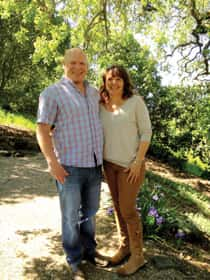"We’re trying to keep the style more traditional and less opulent." —Dan Barwick
 Located in the city’s eastern foothills just within the Russian River Valley AVA, Paradise Ridge Winery in Santa Rosa is a hidden treasure. “We’re a blue island. No one really knows we’re here,” agrees winemaker Dan Barwick. His “blue” reference alludes to the tasting room, which sits high on a Fountaingrove hillside looking across Highway 101 and west toward the coast.
Located in the city’s eastern foothills just within the Russian River Valley AVA, Paradise Ridge Winery in Santa Rosa is a hidden treasure. “We’re a blue island. No one really knows we’re here,” agrees winemaker Dan Barwick. His “blue” reference alludes to the tasting room, which sits high on a Fountaingrove hillside looking across Highway 101 and west toward the coast.
“We can sit here [on the winery terrace] in the sunshine looking down on the fog [in the vineyard]. I’d describe it as an island in the sky,” Barwick continues. “This site is extremely unique. We’re about as north as the real cool fog gets, and the ocean breeze flows over the fog so it’s colder here than even a mile or so away. It’s natural air conditioning that lets us keep bright acidity in the Pinot Noir. I think, without that, we’d be a little too warm for [Pinot Noir].”
A family affair, Paradise Ridge Ranch was founded in 1978, when Walter and Marijke Byck bought the land and planted its first vineyards. For years, the family sold their fruit to local wineries while Walter pursued a medical career and Marijke raised their five children. A Chardonnay vineyard was added in 1985, but it wasn’t until nearly a decade later that circumstances led the couple to pursue a winery of their own.
“Of the 156 acres total, only 16 are planted to vineyards,” says Rene Byck, son and now co-owner (with his sister, Sonia Byck-Barwick, and their three other siblings) of Paradise Ridge Winery. “We’re maintaining a lot of natural habitat and only one tree was removed when we planted the vineyards.”
“We’ve submitted an application to be certified sustainable, which should be complete by mid-May,” Byck continues. “We farm organically but currently aren’t intending to pursue that certification.” It’s this love of the land that links all the pieces of Paradise Ridge, which, in addition to the vineyards, winery and tasting room, includes an event center, sculpture garden, performance amphitheater and historical exhibit about winemaker Kanaye Nagasawa (1852-1934).
In 2008, the family planted its first Pinot Noir vineyard (it had previously sourced Pinot fruit from vineyards in Russian River Valley). “We surprised our father for his 80th birthday and named it Walter’s Vineyard,” says Byck. The five-acre site has two clones, 777 and Pomard, which are blended for the bulk of production (single clone wines are sometimes also produced, depending on quality and volume, but only in very small lots).
“We’re trying to keep the style more traditional and less opulent,” says Barwick. “The key words are ‘food friendly,’ with acidity being the key component to that.”
Byck adds, “Dan’s Pinot style is different than what’s taken over the Pinot world. It’s not high alcohol or high extraction. It’s more delicate—a blend of California and European winemaking style that’s augmented by the terroir.”
“We strive to pick the fruit at the earliest level of ripeness to maintain bright acidity and capture more of the red fruit profile Pinot can display,” explains Barwick. “That means, for our single vineyard, we can harvest as many as four different times based on the topography. The idea is to create a food-friendly, reserved style of Pinot Noir—very restrained—which means very careful use of oak.
“Pinot requires attention to every detail, and this award can only be a result of that attention,” he concludes.
“It’s definitely a great award in this area,” agrees Byck, who continues, “Or in any area, really. But this is the best place to grow Pinot Noir in the United States, so it’s an especially great award here.”



